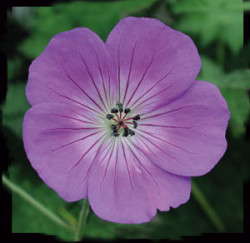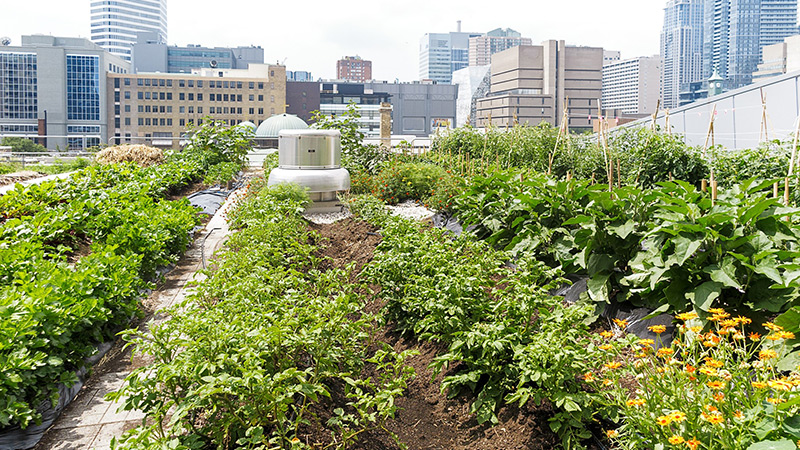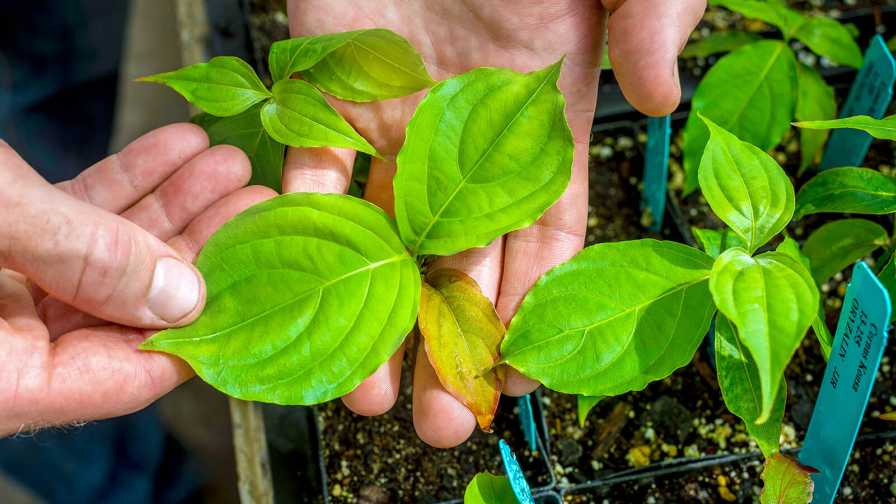Production Tips For Top Performers: Geranium ‘Rozanne’

|
Figure 1 (above). The periwinkle-
blue flowers of ‘Rozanne’ are larger than those of 
most perennial geraniums. Figure 2 (below). ‘Rozanne’ in a 5 1/2-inch pot.
|
Geranium ‘Rozanne’ is such a lovely plant, demand would be high even if it hadn’t been selected as Perennial Plant of the Year for 2008 by the Perennial Plant Association. ‘Rozanne’ is well-deserving of the acclaim, with numerous showy periwinkle-blue flowers accented by lighter centers and reddish veins (Figure 1). This variety is a fantastic garden performer and also very appealing in the pot.
Perennial geraniums (not to be confused with the annual geraniums, botanically known as pelargonium) have the common name of crane’s bill due to the long narrow shape of their seed pods. Comprising more than 250 species, members of this very diverse genus are found throughout the world, primarily in temperate regions. Numerous species and cultivars have become key elements in classic English cottage gardens, and are great additions to any landscape. Their mounded shapes fit well into mixed borders, and their toughness and adaptability make them suitable for many sites.
‘Rozanne’ is a sterile, naturally occurring hybrid of Geranium himalayense and Geranium wallichianum ‘Buxton’s Variety.’ It is propagated by tissue culture and patented by Blooms of Bressingham. Many geraniums bloom for much of the summer, but ‘Rozanne’ has a particularly long bloom season. We have observed flowering into November and even December at our trial gardens at Michigan State University in years when fall weather is mild. The lobed foliage develops attractive russet tones in the fall. ‘Rozanne’ is cold hardy to USDA Zone 5, yet also has better heat tolerance than most crane’s bill. It prefers somewhat moist conditions and full to part sun and benefits from more shade in hotter climates. ‘Rozanne’ is more compact in the pot than most other geranium we’ve worked with, yet it still spreads enough to be attractive in hanging baskets and container gardens (Figure 2).
Forcing
Colorful flowers get customers excited. For maximum sales, plants must be flowering during spring when customers are in the garden centers. At Michigan State University, we have been working for the past 15 years to understand what triggers flowering in hundreds of herbaceous perennials, and developing strategies to force them into flower predictably. Two environmental factors control flowering in many species: some require a period of cold temperatures or vernalization to flower, and many flower in response to daylength. In our research facilities, we provide treatments designed to determine if and how these factors influence flowering.
Treatments
We started with 32-cell plugs of ‘Rozanne’ that had about five leaves each. We gave half of the plugs a cold treatment of 15 weeks in a cooler set at 41ËšF, lighted by fluorescent lamps for nine hours per day. Remaining plants received no cold treatment. All plants were forced in our research greenhouses at 68ËšF, under one of three light treatments: 9-hour short days, 16-hour long days or 16-hour long days with supplemental light.
Results
These perennial geraniums can be produced and
utilized in the landscape along with annuals.
All ‘Rozanne’ plants flowered in six to eight weeks after transplant in all treatments, regardless of cold treatment or photoperiod. ‘Rozanne’ is one of a group of perennials that are as easy to grow as annuals–no special conditions or treatments are needed to have them in flower at market. They can be produced right alongside annuals, and with their long bloom season, they can be used in the landscape with annuals, too (see Figure 3). ‘Rozanne’ plugs tolerated the cold treatment with no problems. Plants that had been cooled formed fewer leaves before blooming and flowered about two weeks sooner than non-cooled plants. Non-cooled plants forced during the winter had 12 to 18 flower buds each when their first flowers opened. Cooled plants forced during spring had 23 to 33 buds each. This difference was at least partly due to higher light levels during spring forcing.
Production Notes
We have used the same medium, a commercial peat-perlite formulation, for hundreds of varieties of perennials with good success and ‘Rozanne’ was no exception. Geraniums are not heavy feeders, and constant feed at 125 ppm nitrogen from a complete fertilizer with micronutrients is adequate for good growth.
5000 ppm B-Nine, 90 ppm Bonzi, 1500 ppm Cycocel, 15 ppm Sumagic.
Plants received weekly spray applications for 5 weeks.
Cycocel suppressed height by more than 20 percent. Both B-Nine
and Bonzi suppressed plant height by 10-20 percent.
Height Control
In our 5 ½-inch containers, ‘Rozanne’ plants were 8 to 15 inches tall when the first flowers opened, and tended to be more compact under higher light levels. They were not aggressive in their growth habit, but did become floppy after extended time in the pot. We tested several growth retardants and found that chlormequat at 1500 ppm reduced stem elongation by more than 20 percent. Daminozide at 5000 ppm or paclobutrazol at 90 ppm each had a lesser effect (Figure 4). We made weekly spray applications for five weeks. Growers will need to fine-tune application rates and frequencies to fit their particular situations.
Similar Cultivar
Growers and gardeners may have noticed another geranium in the marketplace that looks much like ‘Rozanne’: ‘Jolly Bee,’ a Proven Winners selection. Both reportedly have G. ‘Buxton’s Variety’ as one parent but ‘Jolly Bee’ has G. shikokianum var. yoshiianum as its other parent. We have not formally worked with ‘Jolly Bee’ but grew a few in the greenhouse and in our trial gardens, where they flowered readily and generated many positive comments.









